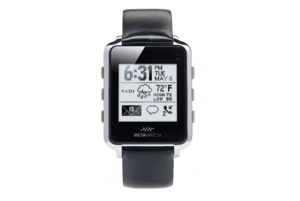When Apple CEO Tim Cook kicked off the D11 conference, he ignited a firestorm of speculation regarding Apple's stake in the wearable computing market. Rumours have long told us that Apple is working on a smartwatch, but now Cook's latest comments cement the speculation that the company is indeed working on wearable technology.
First, let’s look at Cook’s comments. He said, “Wearables are incredibly interesting … it could be a profound area.” He said wearable computing is “ripe for exploration, and it’s ripe for us to get excited about” while acknowledging that there are “lots of things to solve.”, Cook added, “The wrist is natural,” seemingly as a destination for wearable technology.
Clearly, wrist-worn wearables are on Apple's radar. It's a booming new technology category, and a sector that's ripe for Apple's taking. All Cook and company need to do is harness the same expertise and design savvy that propelled existing Apple product lines to greatness.
The promise
Current smartwatches just don’t do that much, and the execution on their existing feature sets is limited. The smartwatch industry is still in its infancy.
This is particularly obvious when we compare the launch of smartwatches with the launch of multitouch smartphones. The first iPhone showed incredible promise, though offered only a small slate of built-in apps, a lousy camera, and not much else. It was clearly more advanced than anything else at the time, and people bought lots of them. If smartwatches can evolve as dramatically over the next six years as the iPhone has over the previous six years, wrist-based computing will go from interesting to awesome very quickly.
Now let's toss wrist-worn sleep and fitness trackers like the Jawbone Up and Fitbit Flex into the mix. I've tested both, and give each device a high rating, but each gadget reminds me of the first iPhone, showing signs of greatness along with room for growth. They work reasonably well, and their software expressions are strong, with pleasant data graphs and friendly social features built into their activity-tracking platforms. But both wristbands are handicapped by limited hardware: You need to launch their connected apps to get a precise window into your activity progress, as neither device sports a display.
If the Pebble, MetaWatch Frame, Jawbone Up and Fitbit Flex tell us anything, it's that wearable computing has legs as an emerging product category. And these devices are quickly being purchased by more than just highly tech-savvy early adopters. My mom, dad, two sisters, wife, and a slew of friends all use some Fitbit device. And it’s not just my Twitter timeline that’s full of Pebble owners: I have neighbors sporting them, too.
So it makes good sense that Apple would want to enter this market. People are interested in, and are already buying, wearable technology—this despite the fact that the current crop is so immature. All of which leads us to Apple's opportunity.
What Apple is good at
Apple’s good at a lot of things, sure, but one of the areas in which it excels is displays. And this is where Apple could immediately make a splash in the wearable market—precisely because the competition hasn't delivered. The Pebble and the MetaWatch Frame both employ two-tone displays that only work well in bright light. The Jawbone Up and Fitbit Flex, meanwhile, don't include any meaningful displays at all.
So you can see where this is going: There’s no reason why we should need both a smartwatch and a pedometer—the features those wearables offer should be combined into a single device. And, assuming there’s a way to surmount the not-insignificant battery hurdles, a beautiful, color touch-display would make a whole lot more sense than the psuedo-e-Ink displays that smartwatches boast today.
Apple wouldn’t stop with a bright, touchable, interactive display on its wearable device. The company could also easily work around the challenges facing most existing accessories today—chiefly, the limitations and flakiness of Bluetooth. Some newer accessories use BTLE, a lower-energy version of Bluetooth 4.0, but that limits what devices can do, and it doesn’t always work reliably. Indeed, I re-pair my smartwatches and step trackers at least a couple times per week.
Should Apple release wearable technology that relies on Bluetooth/BTLE, you can bet that the company would improve iOS’s Bluetooth handling. My money, however, is on Apple pulling an AirPlay. Just as the company introduced AirPlay—a proprietary and arguably superior alternative to Bluetooth for audio streaming—I wouldn’t be the least surprised if it introduced a better take on remote device syncing that eschewed Bluetooth again.
Apple wants you to own an iPhone
Finally, if Apple does make a smartwatch or some other type of wearable technology, it will do so to realize a new spin on the old halo effect. Apple’s long maintained that when customers try out iPods, iPhones, or iPads, they realize that Apple’s really good at what it does, and increasingly turn to Macs the next time they buy a computer.
So when Apple releases its own wearable technology, it’s not going to work with your Android Phone, Windows Phone, or—struggling to keep a straight face here—BlackBerry. You want to wear Apple’s new hypothetical technology? You’re going to need an iPhone.
While Apple’s priority is profit share—and here it’s definitely winning—the company won’t mind selling many more iPhones to customers desperate to get their hands on wearable technology.
Inventions and evolutions
Apple didn’t invent music players, smartphones, or tablets. But the iPod, iPhone, and iPad came to dominate their markets. So when Apple does release its incarnation of wearable technology, expect it to follow paths others have trailblazed but haven't yet perfected. Apple takes inspiration from everywhere, but doesn’t release copycats: Whatever wearable technology comes out of Cupertino will be a distinctly Apple product.
We’ve become spoiled by Apple’s continued ability to invent new, awesome product lines. Whenever Apple’s wearable tech arrives, it will be just in time.






